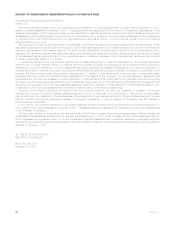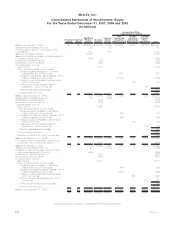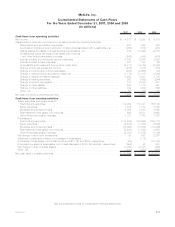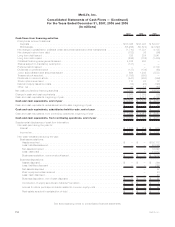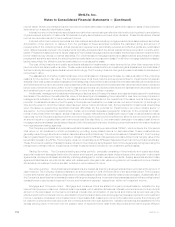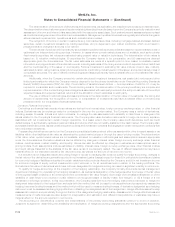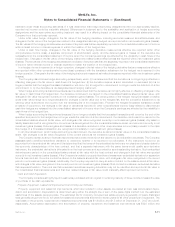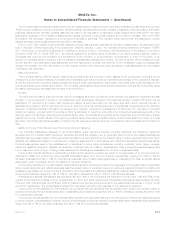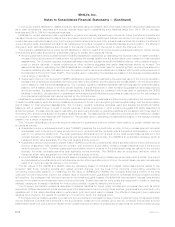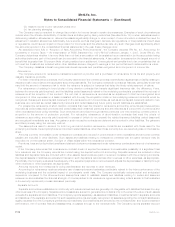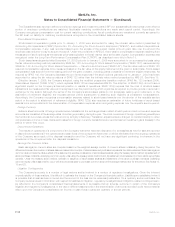MetLife 2007 Annual Report Download - page 104
Download and view the complete annual report
Please find page 104 of the 2007 MetLife annual report below. You can navigate through the pages in the report by either clicking on the pages listed below, or by using the keyword search tool below to find specific information within the annual report.income taxes. All security transactions are recorded on a trade date basis. Investment gains and losses on sales of securities are
determined on a specific identification basis.
Interest income on fixed maturity securities is recorded when earned using an effective yield method giving effect to amortization
of premiums and accretion of discounts. Dividends on equity securities are recorded when declared. These dividends and interest
income are recorded as part of net investment income.
Included within fixed maturity securities are loan-backed securities including mortgage-backed and asset-backed securities.
Amortization of the premium or discount from the purchase of these securities considers the estimated timing and amount of
prepayments of the underlying loans. Actual prepayment experience is periodically reviewed and effective yields are recalculated
when differences arise between the prepayments originally anticipated and the actual prepayments received and currently antic-
ipated. Prepayment assumptions for single class and multi-class mortgage-backed and asset-backed securities are obtained from
broker-dealer survey values or internal estimates. For credit-sensitive mortgage-backed and asset-backed securities and certain
prepayment-sensitive securities, the effective yield is recalculated on a prospective basis. For all other mortgage-backed and asset-
backed securities, the effective yield is recalculated on a retrospective basis.
The cost of fixed maturity and equity securities is adjusted for impairments in value deemed to be other-than-temporary in the
period in which the determination is made. These impairments are included within net investment gains (losses) and the cost basis of
the fixed maturity and equity securities is reduced accordingly. The Company does not change the revised cost basis for subsequent
recoveries in value.
The assessment of whether impairments have occurred is based on management’s case-by-case evaluation of the underlying
reasons for the decline in fair value. The Company’s review of its fixed maturity and equity securities for impairments includes an
analysis of the total gross unrealized losses by three categories of securities: (i) securities where the estimated fair value had declined
and remained below cost or amortized cost by less than 20%; (ii) securities where the estimated fair value had declined and remained
below cost or amortized cost by 20% or more for less than six months; and (iii) securities where the estimated fair value had declined
and remained below cost or amortized cost by 20% or more for six months or greater.
Additionally, management considers a wide range of factors about the security issuer and uses its best judgment in evaluating
the cause of the decline in the estimated fair value of the security and in assessing the prospects for near-term recovery. Inherent in
management’s evaluation of the security are assumptions and estimates about the operations of the issuer and its future earnings
potential. Considerations used by the Company in the impairment evaluation process include, but are not limited to: (i) the length of
time and the extent to which the market value has been below cost or amortized cost; (ii) the potential for impairments of securities
when the issuer is experiencing significant financial difficulties; (iii) the potential for impairments in an entire industry sector or
sub-sector; (iv) the potential for impairments in certain economically depressed geographic locations; (v) the potential for impair-
ments of securities where the issuer, series of issuers or industry has suffered a catastrophic type of loss or has exhausted natural
resources; (vi) the Company’s ability and intent to hold the security for a period of time sufficient to allow for the recovery of its value to
an amount equal to or greater than cost or amortized cost (See also Note 3); (vii) unfavorable changes in forecasted cash flows on
mortgage-backed and asset-backed securities; and (viii) other subjective factors, including concentrations and information obtained
from regulators and rating agencies.
The Company purchases and receives beneficial interests in special purpose entities (“SPEs”), which enhance the Company’s
total return on its investment portfolio principally by providing equity-based returns on debt securities. These investments are
generally made through structured notes and similar instruments (collectively, “Structured Investment Transactions”). The Company
has not guaranteed the performance, liquidity or obligations of the SPEs and its exposure to loss is limited to its carrying value of the
beneficial interests in the SPEs. The Company does not consolidate such SPEs as it has determined it is not the primary beneficiary.
These Structured Investment Transactions are included in fixed maturity securities and their income is generally recognized using the
retrospective interest method. Impairments of these investments are included in net investment gains (losses).
Trading Securities. The Company’s trading securities portfolio, principally consisting of fixed maturity and equity securities,
supports investment strategies that involve the active and frequent purchase and sale of securities and the execution of short sale
agreements, and supports asset and liability matching strategies for certain insurance products. Trading securities and short sale
agreement liabilities are recorded at fair value with subsequent changes in fair value recognized in net investment income. Related
dividends and investment income are also included in net investment income.
Securities Lending. Securities loaned transactions are treated as financing arrangements and are recorded at the amount of
cash received. The Company obtains collateral in an amount equal to 102% of the fair value of the securities loaned. The Company
monitors the market value of the securities loaned on a daily basis with additional collateral obtained as necessary. Substantially all of
the Company’s securities loaned transactions are with large brokerage firms. Income and expenses associated with securities loaned
transactions are reported as investment income and investment expense, respectively, within net investment income.
Mortgage and Consumer Loans. Mortgage and consumer loans are stated at unpaid principal balance, adjusted for any
unamortized premium or discount, deferred fees or expenses, net of valuation allowances. Interest income is accrued on the principal
amount of the loan based on the loan’s contractual interest rate. Amortization of premiums and discounts is recorded using the
effective yield method. Interest income, amortization of premiums and discounts, and prepayment fees are reported in net investment
income. Loans are considered to be impaired when it is probable that, based upon current information and events, the Company will
be unable to collect all amounts due under the contractual terms of the loan agreement. Valuation allowances are established for the
excess carrying value of the loan over the present value of expected future cash flows discounted at the loan’s original effective
F-8 MetLife, Inc.
MetLife, Inc.
Notes to Consolidated Financial Statements — (Continued)


